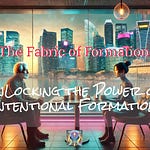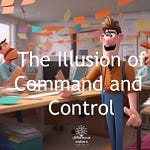Overwhelmed and Out of Bounds
I stared at the mountain of paperwork threatening to avalanche across my desk. Project plans with impossible deadlines, status updates demanding responses, and no fewer than 217 unread emails pulsed accusingly from my screen. My third coffee of the morning sat cold beside my keyboard.
"How am I supposed to keep track of all this?" I muttered, dragging my hand through my hair.
The expectations were crushing. Six months into my new management role, and I still felt like an impostor. Everyone looked to me for answers I didn't have, solutions I couldn't see.
My phone buzzed, skittering across a pile of budget forecasts. Another problem to solve, no doubt. I grabbed it with a sigh.
"Congratulations, Ed! You've been selected for our exclusive Top Talent programme. First session: Golf with Leadership Coach John Michael, Tuesday 9 AM. Clubs provided. Please confirm attendance."
I blinked at the screen. Golf? I'd never held a golf club in my life. And how was whacking a little white ball around a manicured lawn supposed to help me manage this chaos?
"This has to be a mistake," I said to no one in particular.
I'd been hoping for advanced project management training or strategic decision-making workshops—something concrete to tackle the overwhelming responsibilities crowding my days. Not... golf.
My phone buzzed again with a personal message from my director: "Great news about the Top Talent programme, Ed! John Michael is brilliant—his waiting list is usually months long. Lucky you!"
I slumped back in my chair. Apparently, this wasn't a mistake.
The email notification count ticked up to 218. The project timeline on my desk showed three simultaneous deadlines approaching. My team would be waiting for direction in our morning huddle in fifteen minutes.
And instead of equipping me with actual management tools, the company wanted me to play golf.
"Brilliant," I sighed, typing a confirmation message with one hand while reaching for my cold coffee with the other. "Just brilliant."
From Spreadsheet to Fairway
I arrived at the golf course wearing the closest thing I owned to appropriate attire: khaki trousers and a blue polo shirt I'd panic-bought the night before. The clubhouse loomed ahead, all polished wood and privilege—a world away from my cluttered desk and overflowing inbox.
"You must be Ed!" A man with striking white hair and an infectious energy approached, hand extended. "John Michael. Delighted to meet our newest Top Talent."
I shook his hand, forcing a smile. "That's me. Though I should warn you, I've never actually played golf before."
"Perfect!" John's eyes twinkled with unmistakable delight. "Absolute beginners make the best students. No bad habits to unlearn."
After selecting clubs that apparently suited my height and introducing me to terminology that sounded like a foreign language, we headed to the first tee. A young man joined us, carrying both our sets of clubs.
"Ed, this is Amir, our caddie today. One of the best on the course."
Amir nodded respectfully. "Morning, sir."
I watched in awe as John demonstrated a swing that sent his ball sailing gracefully down the fairway. When my turn came, my attempt was considerably less elegant. The ball skittered pathetically off to the right.
"Not to worry," John said, clapping me on the shoulder. "Now, as we walk, let me ask you something important. On an unfamiliar course, even professional golfers rely on caddies who know the terrain. In leadership, who's your caddie?"
I frowned. "I don't follow."
"Look at Amir here. He knows every contour of this course. Every hidden trap. The way the greens break. Without him, we'd be making decisions based solely on what we can see, which is limited."
Amir stepped forward. "This hole has a hidden water hazard to the left, sir. You'll want to aim slightly right of centre."
John nodded. "Specialists in your team need solutions, managers need answers, but leaders—true leaders—need to ask the right questions. Your job isn't to know everything. It's to know who to ask."
I felt a weight lifting from my shoulders as his words sank in. All this time, I'd been killing myself trying to be the expert on everything.
"The best leaders," John continued, "are excellent at asking questions that unlock their team's expertise. They're not threatened by not knowing—they're liberated by it."
The Power of Perspective
I lined up for my second attempt, determined to do better. I gripped the club tightly, my knuckles white with tension. The weight of my company's "Top Talent" expectations felt heavier than the golf club in my sweaty hands.
"Here goes nothing," I muttered, swinging with all my might.
The club head whooshed through the air, missed the ball completely, and buried itself in the turf. The momentum spun me around like a clumsy ballet dancer, and I stumbled forward, nearly falling flat on my face.
Amir winced sympathetically. I felt heat rush to my cheeks, mortified by my performance.
I expected John to launch into technical advice—adjust your grip, bend your knees, keep your eye on the ball—the kind of specific direction I desperately wanted. After all, wasn't that what coaches were supposed to do? Tell you exactly how to fix your problems?
Instead, John simply asked, "What would your most successful colleague do in this situation?"
I stared at him blankly. "What does that have to do with my terrible swing?"
"Humour me," he said with that mischievous twinkle in his eye.
I sighed but played along. "Well, there's Sanjay in Product Development. He's... methodical. Always breaks problems down before tackling them."
As I spoke, I found myself naturally shifting my stance, loosening my death grip on the club. In my mind's eye, I could see Sanjay's calm, measured approach to challenges.
"He wouldn't rush it," I continued, relaxing my shoulders. "He'd probably analyze the mechanics first, take a practice swing or two."
Without thinking, I took a smooth practice swing, feeling the weight of the club.
"And then?" John prompted.
"He'd focus on making clean contact rather than trying to hit it perfectly the first time."
I addressed the ball again, this time with Sanjay's methodical mindset. I swung—not perfectly, but the club connected with a satisfying thwack. The ball arced upward and flew a decent distance down the fairway.
"Well done!" John exclaimed. "Amazing what a change in perspective can do, isn't it?"
A New View
After my surprisingly successful golf swing, we continued walking toward my ball. John carried himself with the relaxed confidence of someone completely at home on the course.
"You did something powerful just now, Ed," he said, his white hair catching the morning sun. "You shifted your perspective. Let's explore that further."
When we reached a wide section of the fairway, John suddenly stopped. He took four tees from his pocket and placed them in the grass, creating a rough square about two meters across.
"Management is essentially about relationships and communication," he explained. "When we get stuck, it's rarely about the facts—it's about perspective."
John pointed to the first tee. "Position 1 is you." He moved to the second. "Position 2 is the other person." He stepped to the third. "Position 3 is a trusted third party." Finally, he indicated the fourth. "And Position 4 is the objective observer—the helicopter view of the entire situation."
I nodded politely, wondering what this had to do with my overwhelming workload.
"Let me show you," John said, beckoning to Amir. "Would you mind helping us with a quick demonstration?"
Amir set down our clubs and joined us. John asked him about a recent conflict he'd experienced at work. Amir mentioned a disagreement with another caddie about client assignments.
"Stand at Position 1 and tell us how you see the situation," John instructed.
Amir stood at the first tee, describing how unfair it felt that the other caddie kept getting the high-tipping members.
"Now move to Position 2," John said. "Become the other caddie. How does the world look from there?"
Amir physically stepped to the second marker. I watched in fascination as his posture subtly changed. His voice took on a different cadence as he spoke from his colleague's perspective.
"I've been here longer... I know these members better... I've put in my time..."
"Position 3," John directed. "You're now the golf director who manages you both."
Amir moved again, his expression shifting to one of thoughtful consideration. "I see two valuable team members with different strengths..."
When Amir reached Position 4—the objective observer—his face suddenly lit up with realization.
"The whole scheduling system needs restructuring," he said, his eyes wide. "Neither of us is wrong, but we're trapped in an outdated process."
I felt my jaw slacken slightly. The transformation was remarkable—a complete breakthrough in under five minutes, simply by physically changing positions.
Unmasking Intent
"Your turn, Ed," John said, pointing to the four tees still arranged in the grass. "What's a current leadership challenge you're facing?"
I hesitated, my mind racing through the myriad problems on my plate. One situation immediately rose to the surface—the one that kept me awake at night.
"There's this developer on my team, Raj. Brilliant coder, probably the most technically talented person we have. But he's..." I searched for a diplomatic way to phrase it. "Difficult."
John nodded encouragingly. "What makes him difficult?"
"He constantly challenges my decisions in team meetings, questions the direction I've set, and takes discussions down technical rabbit holes that waste everyone's time." I felt my shoulders tense as I spoke. "I think he's trying to undermine me."
"Perfect," John said. "That's your Position 1—how you see the situation. Now, step to Position 2 physically. Become Raj."
Feeling slightly ridiculous, I moved to the second tee.
"Now, close your eyes," John instructed gently. "Think about how Raj stands, how he breathes. Adopt his posture."
I thought about Raj's hunched shoulders, the way he leaned forward when speaking about technical details, his rapid-fire speech pattern. Instinctively, I found myself mimicking these traits.
"From this position, why are you speaking up in meetings?" John asked.
The answer came surprisingly easily. "Because no one understands the technical implications of these decisions," I heard myself say in a voice that sounded eerily like Raj's. "The team is heading for disaster if we don't consider the architecture properly."
I felt my breathing quicken, my words becoming more urgent. "I've designed systems like this before. I know what will happen if we continue down this path, but nobody asks my opinion until it's too late!"
Suddenly, I felt a wave of frustration wash over me—not my frustration, but Raj's. And with it came a startling realisation.
"He's not trying to undermine me," I said, opening my eyes wide. "He's feeling undervalued and unheard. He genuinely believes he's trying to save the project."
John's eyes twinkled knowingly. "Interesting shift, isn't it?"
The Art of Adaptive Leadership
After my breakthrough with the four positions exercise, John announced it was time for a team challenge. Two other managers from the Top Talent programme joined us on the next hole—Priya from Marketing and Dwayne from Finance.
"We'll play as teams now," John explained. "But with a twist. After each stroke, I'll change one rule of the game."
"That hardly seems fair," I said.
John grinned. "Leadership rarely is. The question is how you adapt."
We started playing, and true to his word, John threw curveballs at every turn. First, we had to switch clubs after each shot. Then we had to play with our non-dominant hands. Next, we could only communicate in questions.
Just as I was lining up a particularly tricky putt with my left hand while balancing on one foot (John's latest rule), my phone buzzed insistently in my pocket. Normally, I'd have ignored it, but I recognised the ringtone—my team's emergency signal.
"I need to take this," I apologised, stepping away.
It was Ling, my project lead, her voice tight with tension. "Ed, we've hit a critical snag with the Wilson database migration. The client's threatening to pull the contract if we don't resolve it by end of day."
My old instinct roared to life—jump in with solutions, take control, appear decisive. But I caught John watching me from the fairway, and remembered our exercise.
Instead of barking orders, I asked, "What does this look like from the development team's perspective?"
A surprised pause on the line. "Well, they're saying the specifications were unclear from the start."
"And from the client's viewpoint?"
"They believe we promised functionality that wasn't delivered."
I took a deep breath. "What about from a neutral observer's position—someone with no stake in the project?"
I heard Ling typing, presumably taking notes. "I suppose they'd see misaligned expectations on both sides, with neither party taking responsibility for clarification."
"That's insightful, Ling. Now, who on our team has the most experience with similar migration issues?"
"Actually, Raj handled something like this last quarter."
"Perfect. Let's get him involved immediately."
When I hung up, I noticed something remarkable—Ling had thanked me for "helping her see the whole picture" rather than just solving the immediate crisis.
Transformative Insights Under the Oak Tree
After we finished the hole, John gathered our small group under the shade of a towering oak tree. The breeze rustled through the leaves as we settled on a wooden bench, gratefully accepting the water bottles Amir distributed.
"You all handled that leadership test differently," John observed, his white hair catching the sunlight. "Ed, I noticed something particularly interesting about your approach when that call came in."
I felt suddenly self-conscious. "Did I fail the test by taking the call?"
"Quite the opposite," John smiled. "You demonstrated something profound—the ability to shift perspective in a real crisis. That's what effective leaders do."
He reached into his golf bag and pulled out a small, well-worn book. I recognised it immediately as a Bible.
"There's ancient wisdom about this very thing," he said, finding his place without needing to check the reference. "'Do not conform to the pattern of this world, but be transformed by the renewing of your mind.'"
"Romans 12:2," Dwayne murmured beside me.
John nodded. "Exactly. This verse isn't just spiritual advice—it's practical leadership wisdom. The world pushes us toward reactionary thinking, toward fixed patterns and assumptions. But transformation happens when we deliberately renew our minds—when we shift perspectives."
His words resonated with my earlier experience on the phone with Ling. Instead of jumping to my usual solution-focused response, I'd genuinely renewed my thinking by considering multiple viewpoints.
"The four positions we practiced," John continued, "are simply a practical application of this ancient principle. When you step into different perspectives, you're literally renewing your mind—seeing with fresh eyes."
I thought about my situation with Raj and how completely my understanding had shifted once I viewed the situation through his eyes. "It's not just about empathy, is it? It's about accessing wisdom I couldn't see from my original position."
John's eyes lit up. "Precisely! The renewal of your mind isn't just feeling differently—it's thinking differently. And when you think differently, you lead differently."
Harmonising Perspectives in the Boardroom
Three weeks after my golf course epiphany with John Michael, I found myself facing a boardroom of tense faces. Our quarterly strategy meeting had devolved into the usual territorial squabbles between departments.
"The development timeline you're suggesting is completely unrealistic," Sarah from Engineering said, her arms crossed tightly.
Marcus from Sales leaned forward aggressively. "And your technical limitations are killing our competitive edge. Clients are walking away!"
The familiar tension headache began to pulse behind my eyes. Previously, I'd have either tried to placate everyone with vague promises or desperately offered technical solutions to problems I barely understood.
Instead, I stood up and quietly moved to an empty chair on the opposite side of the table.
The heated exchange faltered. Confused glances darted my way.
"Ed?" Sarah questioned. "What are you doing?"
I settled into the new seat—Position 2 in John's framework. "I'm looking at this from Sales' perspective," I explained. "From here, I can see that every day without that feature means lost revenue and damaged client relationships."
I asked Marcus questions about specific client challenges, not defensively, but with genuine curiosity. After fully exploring his viewpoint, I moved to another chair.
"Now I'm sitting in Engineering's position," I said. "The architecture changes you're requesting would require rebuilding the core system, risking stability for existing clients."
I continued moving around the table, each time adopting the perspective of a different stakeholder—even the end users who weren't present.
When I finally returned to my original seat, the atmosphere had transformed. People were nodding thoughtfully rather than preparing their next arguments.
"How did you do that?" Priya whispered beside me.
"It's something I learned recently," I replied. "I call it 'Who's Your Caddie?' because it's about accessing the specialised knowledge each person brings, seeing the course through their eyes."
David from Product Development leaned in. "That physical movement thing—it actually shifted something in the conversation."
"Exactly," I said. "When we physically change our position, our mental perspective often follows."
By meeting's end, we'd found a phased approach that addressed both teams' primary concerns. As people gathered their things, several colleagues asked me to explain the technique more fully.
I couldn't help smiling, remembering John's words about leaders asking the right questions rather than providing all the answers.
A Note on Perspective: Real Stories, Real Change
This story is based on the real experiences of our clients who have successfully implemented these MAD Coaching Habits in their professional lives. While we've changed names, locations, and added narrative elements to protect privacy and enhance readability, the core challenges, breakthroughs, and transformations are authentic. The "Who's Your Caddie?" technique has helped numerous leaders like Ed shift from being answer-providers to perspective-seekers, fundamentally transforming their approach to leadership and problem-solving. These proven methods have created meaningful change in organisations across various industries, demonstrating that the simple practice of shifting perspectives can lead to profound leadership development. We share these experiences in story form because we've found that narrative helps these powerful techniques stick in ways that traditional training often cannot.
Who’s Your Caddie? MAD Steps
As a leadership coach, I've seen how shifting perspectives can transform not just decisions but entire careers. Ed's journey from overwhelmed manager to insightful leader isn't just a story—it's a pathway you can follow this week. Let me guide you through practical steps to implement the "Who's Your Caddie?" approach in your own leadership context.
We'd also love to hear from you! Share your thoughts and experiences in the comments—your feedback truly warms our hearts.
Who’s Your Caddie? MAD Steps
As a leadership coach, I've seen how shifting perspectives can transform not just decisions but entire careers. Ed's journey from overwhelmed manager to insightful leader isn't just a story—it's a pathway you can follow this week. Let me guide you through practical steps to implement the "Who's Your Caddie?" approach in your own leadership context.

















Share this post